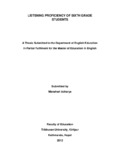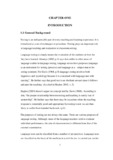Please use this identifier to cite or link to this item:
https://elibrary.tucl.edu.np/handle/123456789/440| Title: | Listening Proficiency of Sixth Grade Students |
| Authors: | Acharya, Manahari |
| Keywords: | Proficiency;Language Skill;Listening Skill;Government-aided School |
| Issue Date: | 2012 |
| Publisher: | Central department of English Education |
| Institute Name: | Central Department of Education |
| Level: | Masters |
| Abstract: | The thesis entitled "Listening proficiency of Sixth Grade Students" is dealt with the listening proficiency of grade six students of Kathmandu valley as a whole. In order to carry out this research, I collected data from government- aided and private schools from the students studying in Kathmandu valley. The total sample population of the study consisted of 40 students who were selected by using non-random judgemental sampling procedure. I used a test as a main tool which comprised of three types of test items based on ‘Our English Book Grade Six.’ The tests were designed to test the listening proficiency in word, phrase and sentence levels. The total number of test items was 30, each test items carrying 2 score. The scores obtained by the students were tabulated on the basis of the objectives specified. The findings of the study show that the average listening proficiency of the sixth graders is 63.45 per cent. The study shows that the students of private schools are far more proficient than those of government-aided schools where the students of government-aided school have obtained 72 per cent in listening word, phrase and sentence as a whole, the students of public school have obtained 54.91 per cent only. Similarly, in word, phrase and sentence level, I could not find vast difference in listening proficiency between girls and boys where boys obtained 63.25 per cent and girls obtained 63.66 per cent. I found equal proficiency in word and phrase i.e. 73.5 per cent and 72.25 per cent. But they have least proficiency in listening sentence i.e. 44.62 per cent only. The study consists of four chapters. Chapter one deals with general background, review of related literature, objectives of the study and significance of the study. Chapter two deals with methodology. It consists of sources of data, sampling population and procedure, tools for data collection, procedure of data collection and limitation of the study. Chapter three deals with analysis and interpretation of the data. The data has been analyzed under grammatical units, gender and school-wise comparison. Chapter four deals with findings and recommendations on the basis of the findings. |
| URI: | http://elibrary.tucl.edu.np/handle/123456789/440 |
| Appears in Collections: | English Language Education |
Files in This Item:
| File | Description | Size | Format | |
|---|---|---|---|---|
| cover.pdf | 33.96 kB | Adobe PDF |  View/Open | |
| CHAPTER.pdf | 109.83 kB | Adobe PDF |  View/Open |
Items in DSpace are protected by copyright, with all rights reserved, unless otherwise indicated.
